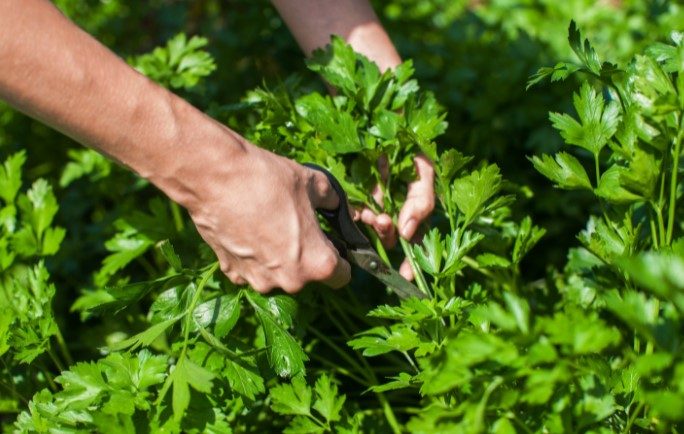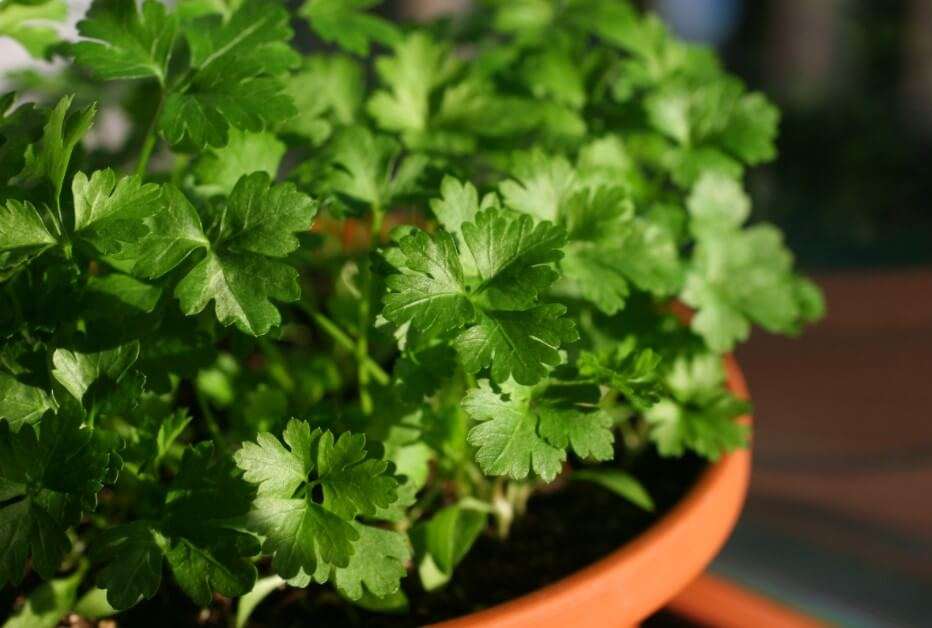There are many good reasons for knowing how to grow parsley at home. Give your cooking an extra zest and flavor profile by immediately picking the fresh leaves.
Parsley has a rich, earthy flavor with a slightly zesty and bitter tang, a perfect companion for dishes like soup, seafood stew, salads, and pasta. Parsley is also rich in vitamin A and C and multiple antioxidants, like carotenoids and flavonoids.
Here is a simple guide to follow if you want to grow parsley at home.
In this post
Several Ways to Grow Parsley

There are two methods you can do to grow parsley: seed sowing and propagation.
The first involves sowing seeds directly in the soil, and the second uses clippings from a fully grown parsley plant. Both methods have benefits, so consider your personal needs before choosing one.
Seed sowing is the most straightforward method. You can buy seeds from a gardening supply store and plant them indoor or outdoor. It also has a good success rate, providing you follow the proper planting methods.
Propagating parsley from cuttings has a slightly lower success rate. You should plant at least twice the numbers you plan, just in case.
However, this method gives you fresh parsley way faster than growing the herb from seeds.
I suggest you planting parsley by combining these two methods, especially if you want continuous fresh parsley supply.
Since parsley withers and dies after the second harvest, you can collect the seeds and use them for planting the next batch. Don’t forget to take fresh cuttings from the plants you grow to give an early harvest too!
Steps to Grow Parsley from Cutting
Want to get your fresh parsley quickly for home cooking? Here is how to grow parsley from fresh cuttings you can immediately try.
1. Choose the Right Cuttings
Get your cuttings from fresh parsley, preferably from a market or fresh food store.
Choose cuttings that are four to five inches long (around 10 to 12 cm). Make sure they are green, healthy, without brown spots or wilted parts.
2. Prepare Cuttings for Planting
Create a 45-degree angle when snipping the bottom part of the parsley cuttings. Remove the bottom leaves from the part that you will submerge in water.
3. Place the Cuttings in Water
Encourage the growth by putting the cuttings in water, with the leafless area submerged. Make sure the water is distilled.
If you want to speed up the growth, crush an aspirin tablet and pour it into the water as homemade growth “formula”. Place it near a direct light source.
4. Move to the First Transplant Soil
After the cuttings show root growth, move them into the soil as your first transplant medium.
Parsley loves rich, well-draining soil. Bore a hole 1.5-inch deep (around 3.5 cm) and plant the bottom part of the cutting there.
Cover the area behind it with soil without leaving air.
5. Move to the Final Planting Medium
Check the cuttings after two weeks. If they get wilted or brown, get rid of them. However, if you see roots growing from the cuttings, move them to the final planting media (rich soil in larger planters or raised beds).
If you use a planter or pot, make sure it is at least 25 to 30 cm wide to provide the herb with an adequate water supply.
How to Take Care of Parsley

Once you move parsley plants into the soil, do not forget to take care of them properly. Here are things you must do to make your parsley healthy.
1. Water Moderately
Parsley loves moist soil but hates overwatering since it causes fungal infection. The key is watering just enough not to let the surface of the soil dry out. Water the bottom part of the plant, so you do not wet the leaves.
2. Allow Full Sun
Parsley loves full sunlight, so make sure your plant gets at least six to eight hours of direct sunlight every day.
3. Trim and Mulch
Trimming and mulching are important care methods for parsley during the winter (or colder season).
Make sure the mulch is about two to three inches (around five to 7.5 cm) so that the soil around the parsley does not freeze. As for the trimming, make sure you do that every fall.
4. Protect Plant from Wind
Parsley cannot handle strong wind, so having a greenhouse (even the tiny one) is a good option for taking care of a lush herb garden.
If you plant parsley in removable planters, take them inside during winter or windy weather.
5. Provide Adequate Light on Winter
When the winter comes and the parsley does not get enough light, make sure to maximize the light exposure.
If your parsley is still young and in a removable planter, use an LED light above the plant.
If the plant is already big, place the planter near a window, and rotate the position, so every part gets enough light exposure.
Good Companion Plants for Parsley
Parsley flowers attract pest predators and butterflies, so it is good to have companion plants if you plant parsley outdoor. Here are some good choices to accompany your parsley:
1. Tomatoes
Tomatoes have aphids as common preys, but parsley attracts aphid predators like hoverflies. Plus, tomatoes and parsley go together as supporting ingredients in various dishes, especially Italian.
2. Pole/Bush Beans
Pole or bush beans can benefit from parsley’s ability to attract tachinid flies. These flies are natural predators to cutworms, beans’ common pests. These beans also provide extra nutrients for parsley by adding nitrogen to the soil.
3. Roses
Want something beautiful to plant among your parsleys? Roses are great options. Roses are vulnerable to aphids and sawflies, and parsley attracts hoverflies that prey on them.
4. Asparagus
Parsley attracts bugs that eat asparagus beetles. Both plants also encourage each other’s growth. Asparagus dan parsley do not grow at the same time, so they can “fill” empty spaces between each other.
5. Corns
Parsley attracts parasitic wasps that prey on corn’s natural predators, like cutworms and earworms. Plus, tall corns provide enough shade for parsley without reducing the exposure toward warm weather and full sun.
On the contrary, avoid lettuces and allium plants like shallots, onions, and garlic near the parsley since they can hinder healthy growth. Plants from the same family with parsley, like carrots, must be avoided since they attract similar pests.
How to Harvest Parsley

Now that you know how to grow parsley, you must also know the proper way to harvest it. You want to get enough bunch without damaging the entire plant.
The best way is to cut the sprigs near the ground level. If you need a lot of parsley, grab a bunch as much as you need and snip them altogether near the ground level.
- Cutting on this height allows your parsley to stay productive for at least another harvest.
- Avoid picking the leaves directly from the stem since it will hinder growth and reduce productivity.
- Use a sharp and clean scissor or pruning shear to harvest the parsley.
How to Store Parsley Properly
There are several practical ways to store parsley. If you only need to keep it fresh before cooking, place the parsley sprigs in a glass or container with water. Place it in the fridge until you are ready to cook with the cut sprigs.
Drying
Drying is another popular method for long-term storage. Hang or place your parsley sprigs in a warm, well-ventilated space.
Then, let the air and warmth slowly dry the parsley. Separate the leaves from the stems and store them in an airtight jar or container.
Freezing
Want to have parsley with a milder flavor than the fresh or dried one? Try freezing the herb.
Chop the fresh, washed parsley finely before putting them into an ice cube tray (measure the cuts, so each tray section contains one serving).
Fill the tray with water and store it in the freezer. Make sure to use it up all within one year.
FAQ about Growing Parsley
When is the best time to plant parsley?
Fall is the best time to plant parsley since the plant yields more harvest. Fall parsley will bloom in May or June and receive the maximum amount of light.
Where does parsley grow best?
Parsley loves loamy, rich, well-draining soil under full sun. You can add compost to the soil at the start of the season to make it grow faster and more healthily.
How often should parsley be watered?
Parsley needs regular watering. Two to three times every week is the standard count. Parsley should always have moist soil but not flooded.
Can you revive dead parsley?
Lack of water will make the parsley wilted. Revive it by water the parsley until the soil around its root is damp. Check with your finger to see if the soil is damp up to three inches (around seven cm). If the soil is not loamy enough, dig it in the evening and add some gritty matters like sand for extra percolation.
Parsley is a great herb to improve flavor profile in various dishes. Knowing how to grow parsley will give you a constant supply of fresh herbs, which you can dry and even freeze.

